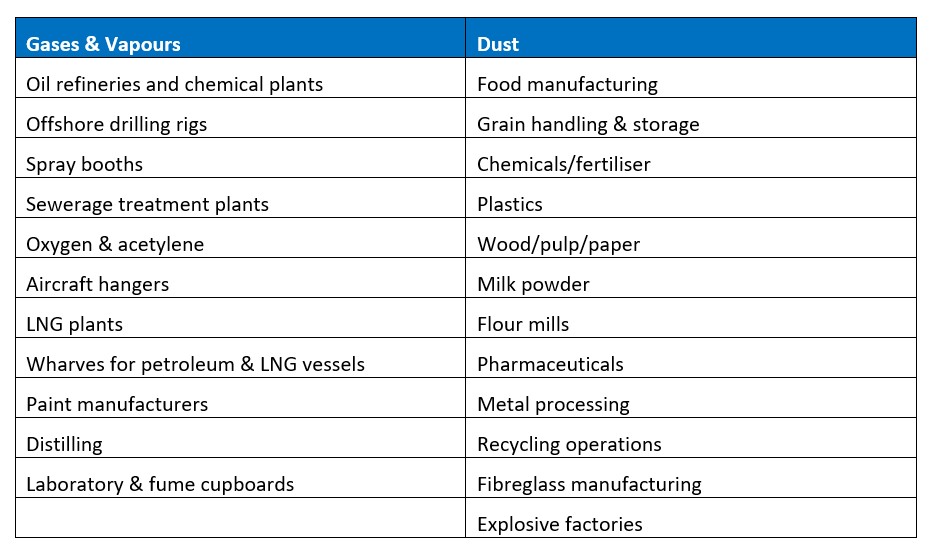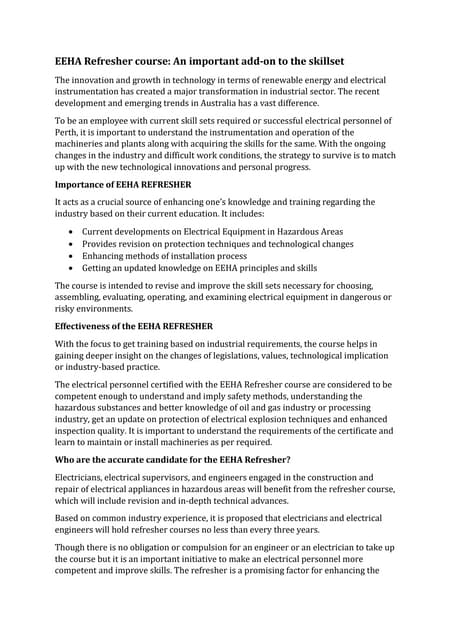Roar Solutions Can Be Fun For Anyone
Roar Solutions Can Be Fun For Anyone
Blog Article
The smart Trick of Roar Solutions That Nobody is Talking About
Table of ContentsNot known Facts About Roar SolutionsAn Unbiased View of Roar SolutionsNot known Facts About Roar Solutions
In order to secure installations from a potential explosion a method of analysing and classifying a potentially dangerous area is required. The purpose of this is to make certain the proper selection and setup of devices to ultimately stop an explosion and to guarantee security of life.
(https://sandbox.zenodo.org/records/174151)
No tools needs to be mounted where the surface temperature level of the tools is more than the ignition temperature of the offered risk. Below are some usual dirt hazardous and their minimum ignition temperature. Coal Dirt 380C 225C Polythene 420C (melts) Methyl Cellulose 420C 320C Starch 460C 435C Flour 490C 340C Sugar 490C 460C Grain Dust 510C 300C Phenolic Resin 530C > 450C Aluminium 590C > 450C PVC 700C > 450C Soot 810C 570C The likelihood of the hazard existing in a concentration high enough to create an ignition will vary from location to place.
Unsafe area electric tools perhaps created for use in higher ambient temperature levels. Field Repair Service By Authorised Personnel: Complex screening might not be called for however certain treatments might need to be adhered to in order for the tools to keep its 3rd celebration ranking. Each item of tools with an unsafe ranking ought to be reviewed individually.
A Biased View of Roar Solutions
The equipment register is a detailed database of equipment records that consists of a minimum collection of fields to determine each item's area, technological criteria, Ex category, age, and environmental information. This info is essential for monitoring and taking care of the tools properly within dangerous locations. In contrast, for regular or RBI sampling evaluations, the quality will be a combination of In-depth and Close assessments. The ratio of Detailed to Shut evaluations will be figured out by the Devices Danger, which is examined based on ignition risk (the possibility of a source of ignition versus the likelihood of a combustible environment )and the hazardous area category
( Zone 0, 1, or 2). This variation will also affect the resourcing requirements for job preparation. When Lots are defined, you can create sampling strategies based on the example size of each Whole lot, which refers to the variety of arbitrary equipment items to be checked. To determine the needed example dimension, 2 facets need to be reviewed: the size of the Whole lot and the category of examination, which suggests the level of effort that need to be applied( minimized, regular, or enhanced )to the inspection of the Great deal. By integrating the category of inspection with the Great deal dimension, you can then establish the ideal denial criteria for an example, suggesting the permitted number of defective products found within that sample. For more details on this process, please describe the Energy Institute Guidelines. The IEC 60079 typical advises that the maximum period in between assessments must not exceed three years. EEHA evaluations will certainly additionally be performed beyond RBI campaigns as component of set up upkeep and tools overhauls or fixings. These evaluations can be attributed toward the RBI example sizes within the influenced Lots. EEHA evaluations are carried out to recognize faults in electrical equipment. A heavy scoring system is important, as a solitary tool might have numerous mistakes, each with differing levels of ignition danger. If the combined rating of both evaluations is less than twice the fault rating, the look at this now Whole lot is deemed appropriate. If the Whole lot is still thought about inappropriate, it has to undergo a complete examination or validation, which may trigger more stringent assessment methods. Accepted Lot: The root causes of any type of mistakes are determined. If a common failure mode is located, extra tools might need maintenance. Faults are identified by intensity( Security, Honesty, Housekeeping ), making sure that urgent issues are analyzed and attended to immediately to reduce any influence on safety and security or procedures. The EEHA database must track and record the lifecycle of faults along with the rehabilitative actions taken. Carrying out a durable Risk-Based Evaluation( RBI )strategy is crucial for making certain conformity and safety and security in handling Electrical Devices in Hazardous Areas( EEHA) (hazardous area course). Automated Mistake Scoring and Lifecycle Monitoring: Effortlessly take care of mistakes and track their lifecycle to improve evaluation precision. The introduction of this support for risk-based evaluation further reinforces Inspectivity's position as a best-in-class option for governing compliance, along with for any asset-centric evaluation use situation. If you are interested in discovering more, we invite you to ask for a presentation and discover exactly how our option can change your EEHA monitoring procedures.
Roar Solutions - An Overview

In terms of eruptive threat, a hazardous area is a setting in which an eruptive atmosphere exists (or may be anticipated to be existing) in amounts that call for special safety measures for the building and construction, installation and use of equipment. eeha. In this post we explore the difficulties dealt with in the work environment, the threat control measures, and the needed competencies to function securely
These materials can, in certain problems, create eruptive ambiences and these can have major and unfortunate consequences. Most of us are acquainted with the fire triangular get rid of any kind of one of the 3 components and the fire can not happen, yet what does this mean in the context of dangerous areas?
In many circumstances, we can do little concerning the degrees of oxygen airborne, however we can have substantial influence on sources of ignition, for instance electrical equipment. Dangerous locations are documented on the harmful area classification illustration and are determined on-site by the triangular "EX" indication. Here, among other key details, zones are split right into three types depending on the hazard, the chance and duration that an eruptive atmosphere will exist; Zone 0 or 20 is regarded the most dangerous and Area 2 or 22 is regarded the least.
Report this page